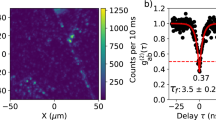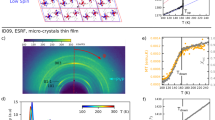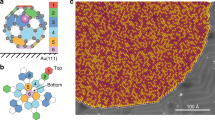Abstract
The controlled manipulation and switching of single atoms and molecules raise the prospect of ultra-high-density data storage. Switching by motion of a single atom has been reported1, and techniques of single-molecule optical detection and spectroscopy2 in the condensed phase have been refined to a degree that allows the modification of the absorption properties of a single chromophore3. Light-induced jumps in single-molecule excitation frequencies have been reported3,4,5, but in none of these cases could the process be controlled: the jumps varied from molecule to molecule, they were interrupted by spontaneous jumps, and the new excitation frequencies could not be identified unambiguously. Here we report light-induced reversible frequency jumps ofsingle molecules of the aromatic hydrocarbon terrylene embedded in a particular site of a p-terphenyl host crystal6 at temperatures of around 2 K. The changes in absorption frequency for different terrylene molecules were identical (within 0.5%) for all samples studied. Thus we were able to switch single-molecule absorption lines in a controlled way between well-defined frequency positions.
This is a preview of subscription content, access via your institution
Access options
Subscribe to this journal
Receive 51 print issues and online access
$199.00 per year
only $3.90 per issue
Buy this article
- Purchase on Springer Link
- Instant access to full article PDF
Prices may be subject to local taxes which are calculated during checkout



Similar content being viewed by others
References
Eigler, D. M., Lutz, C. P. & Rudge, W. E. An atomic switch realized with the scanning tunnelling microscope. Nature 352, 600–603 (1991).
Basché, Th., Moerner, W. E., Orrit, M. & Wild, U. P. (eds) Single-Molecule Optical Detection, Imaging and Spectroscopy (VCH, Weinheim, 1997).
Basché, Th. & Moerner, W. E. Optical modification of a single impurity molecule in a solid. Nature 355, 335–337 (1992).
Fleury, L., Zumbusch, A., Orrit, M., Brown, R. & Bernard, J. Spectral diffusion and individual two-level systems probed by fluorescence of single terrylene molecules in a polyethylene matrix. J. Lumin. 56, 15–28 (1993).
Moerner, W. E.et al. Optical probing of single molecules of terrylene in a Shpol'skii matrix: a two-state single molecule switch. J. Phys. Chem. 98, 7382–7389 (1994).
Kummer, S., Basché, Th. & Bräuchle, C. Terrylene in p-terphenyl: a novel single crystalline system for single molecule spectroscopy at low temperatures. Chem. Phys. Lett. 229, 309–316 (1994); Chem. Phys. Lett. 232, 414 (1995).
Kador, L., Müller, A. & Richter, W. Single molecule spectrosocpy and persistent hole-burning of terrylene in p-terphenyl: external field effects. Mol. Cryst. Liq. Cryst. 291, 23–29 (1996).
Basché, Th., Kummer, S. & Bräuchle, C. Direct spectroscopic observation of quantum jumps of a single molecule. Nature 373, 132–134 (1995).
Moerner, W. E. (ed.) Persistent Spectral Hole-Burning: Science and Application (Springer, Berlin, 1988).
Myers, A. B., Tchénio, P., Zgierski, M. Z. & Moerner, W. E. Vibronic spectroscopy of individual molecules in solids. J. Phys. Chem. 98, 10377–10390 (1994).
Tchénio, P., Myers, A. B. & Moerner, W. E. Vibrational analysis of the dispersed fluorescence from single molecules of terrylene in polyethylene. Chem. Phys. Lett. 213, 325–332 (1993).
Kummer, S.et al. Absorption, excitation and emission spectroscopy of terrylene in p-terphenyl: bulk measurements and single molecule studies. J. Chem. Phys.(submitted).
Baudour, J. L., Delugeard, Y. & Cailleau, H. Structure cristalline de la phase basse température du p-terphényle à 113 K. Acta Crystallogr. B 32, 150–154 (1976).
Reilly, P. D. & Skinner, J. L. Spectral diffusion of individual pentacene molecules in a p-terphenyl crystal: stochastic theoretical model and analysis of experimental data. J. Chem. Phys. 102, 1540–1552 (1995).
Ambrose, W. P. & Moerner, W. E. Fluorescence spectroscopy and spectral diffusion of single impurity molecules in a crystal. Nature 349, 225–227 (1991).
Acknowledgements
We thank C. Kryschi for discussions. This work was supported by the Deutsche Forschungsgemeinschaft.
Author information
Authors and Affiliations
Rights and permissions
About this article
Cite this article
Kulzer, F., Kummer, S., Matzke, R. et al. Single-molecule optical switching of terrylene in p-terphenyl. Nature 387, 688–691 (1997). https://doi.org/10.1038/42674
Received:
Accepted:
Issue Date:
DOI: https://doi.org/10.1038/42674
This article is cited by
-
Modification of single molecule fluorescence using external fields
Frontiers of Physics (2017)
-
Impact of local compressive stress on the optical transitions of single organic dye molecules
Nature Nanotechnology (2014)
-
Biosilicated CdSe/ZnS quantum dots as photoluminescent transducers for acetylcholinesterase-based biosensors
Analytical and Bioanalytical Chemistry (2010)
Comments
By submitting a comment you agree to abide by our Terms and Community Guidelines. If you find something abusive or that does not comply with our terms or guidelines please flag it as inappropriate.



